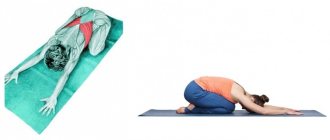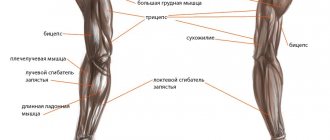What exercises can you do right at your workplace? How to maintain your posture while working in the office? Fitness trainer says.
A sedentary lifestyle has become the norm for millions of Russians. We spend hours scrolling through social networks, watching TV series all night long, driving for groceries - but our body needs physical activity.
Egor Fukalov
fitness trainer
Shares a set of exercises for those who work in the office.
Human physiology has remained virtually unchanged since the days of mammoth hunting. But now we spend 6 to 10 hours every day working in the office. A sedentary lifestyle consumes more than 50% of your emotional resources. There is no energy left for sports and fitness.
Many people are familiar with the feeling when after a working day you feel overwhelmed, even though you haven’t physically done anything like that. The reason is lack of physical activity.
Photo: unsplash.com/@kerenlevand
How has a person’s lifestyle changed in terms of calories:
| Ancestor 30 thousand years ago | Calories burned | Modern Russian | Calories burned |
| Hunting for a fleeing animal | 500 kcal | Buying food on the way to work | 150 kcal |
| Fruit picking | 250 kcal | Eating breakfast while sorting email | 100 kcal |
| Fleeing from an attacking beast | 500 kcal | Eating fruit while watching a video | 100 kcal |
| The Pursuit of Smaller, Affordable Breakfast | 600 kcal | Attending a two-hour meeting | 250 kcal |
| Transporting loot to the cave | 350 kcal | Walk to the store | 200 kcal |
| Cutting meat and preparing wood for the fire | 300 kcal | Talking on the phone | 50 kcal |
| Cooking and eating breakfast | 150 kcal | Reheating dinner in the microwave | 50 kcal |
Try to diversify your workday with exercise. Keep yourself in shape right in the office. You will need 10-15 minutes and a support group in the form of colleagues.
A set of effective exercises for dream posture
How many pull-ups should a man do at different ages?
Monday's selection. Gymnastics in the workplace
Do you think that sitting at a computer you won’t be able to do anything useful for your body, such as therapeutic exercises for your back and neck? Nothing like this. If your job involves spending many hours behind a monitor, pay attention! Just a few simple exercises during the day will help relieve fatigue from sitting for a long time at the workplace, and most importantly, avoid many problems with the spine, joints, get rid of pain in the back, neck, eyes, and headaches.
A set of exercises for the spine and joints
A set of special exercises can be done right at your workplace - a chair or armchair - without wasting time. You need to exercise at least three times a week. Ideally - every day. Take care of yourself and your health.
Exercises for the cervical region
The cervical spine suffers the most from sitting. Gymnastics for the neck will help relieve pain in the neck, cervical-collar area, avoid headaches, osteochondrosis and improve posture. They need to be performed especially carefully, slowly, with a small amplitude
.
1. In a sitting position, bend your neck, bringing your chin as close to your chest as possible. Then slowly tilt your head back, trying to see the ceiling. Extension of the neck must be done while inhaling, and flexion while exhaling. Repeat 5 times.
2. Grasp the back of your head with your hands, folding them into a lock. Press the back of your head onto your hands, and resist with your hands. This exercise develops the neck muscles well.
3. Turn your head to the left, fix it in this position, and then turn to the right. Repeat 5-10 times.
4. In a sitting position, “draw” numbers from 0 to 9 with your nose in the air, drawing all the elements. The range of motion of the neck should be full.
5. Gently rotate your head, first clockwise, then in the opposite direction. Repeat 2-3 times. This exercise not only strengthens the neck muscles and forces the vertebrae to work, but also trains the vestibular apparatus.
Exercises for abdominal muscles
- Pull your stomach in, count to 5, return to the starting position. Repeat 10 times. Over time, it is desirable to increase the counting time to 10, and the number of repetitions of the exercises to 20. By the way, this exercise can be done not only at home or in the office, but also on the way to work.
- Sit with a straight back, pull the top of your head up. Tighten and relax your abdominal muscles 10–20 times.
- Complicated option. From a sitting position, raise your knees up. The higher you reach, the greater the load. 10–20 times is enough.
Waist exercises
Waist exercises. Rotations on a chair are an excellent exercise for “thinning” your waist. You need to keep your back straight, your shoulders remain in place. This exercise helps train your oblique abdominal muscles. 10–20 rotations a day – and the extra centimeters on your sides will begin to melt away.
Relaxing exercises for legs and feet
Take a pencil, put it under the table, take off your shoes and roll the pencil with your feet on the floor. You can do this exercise for an unlimited amount of time; it does not require much physical effort, but it relaxes, relieves stress, improves blood circulation and is an excellent prevention of varicose veins.
Exercises for hands
- Quickly clench the fingers of both hands into fists. On the count of 10, clench your fists as tightly as possible, hold them clenched for 3-5 seconds, relax your fingers and shake them as if shaking water off them.
- Grab your left hand by the wrist with your right, rotate the hand 5 times clockwise and the same number of times in the opposite direction. Repeat this exercise for your right hand.
Warm-up of the thoracic and lumbar spine
According to statistics, about 40% of office workers suffer from back pain. One of the most vulnerable parts of the spine, which bears increased load, is the lumbar spine. As a result, at the end of the working day, many experience fatigue, tightness and discomfort in the lower back. To avoid this, you can perform the following exercises for the spine during the working day.
1. This is a very simple exercise; you can do it right on your office chair. We put our hands on the back of the head, fold them into a lock. Inhale, bend back. As you exhale, bend forward. The exercise is repeated 4 times.
2. Sitting on a chair with a straight back, spread your legs slightly apart. You need to raise your hands up, clasp your left wrist with your right hand. Then lean to the right, stretching your left arm. In this case, the tension of all muscles on the left side should be felt. After this, change the position of your hands and the side of the tilt. Repeat 5-10 times in each direction.
3. Sit in the middle of the chair with your feet slightly apart. Grab the back of the seat with your left hand. Reach with your right foot to your left foot. Stretch slightly, turning your body to the left. Maintain this position for a few seconds, feeling the tension in your back muscles, then return to the starting position, relax and repeat the exercise, changing your hand and side of rotation.
4. Do the “scissors” exercise in the horizontal plane 5-10 times. As you inhale, bring your arms together, and as you exhale, spread them apart.
Light stretching
Straighten your shoulders and stretch the top of your head up. Then raise your hands clasped above your head and stretch yourself upward. You can then lean to the right and left, while trying not to lift your gluteal muscles off the chair and opening your chest. And follow your hands with your eyes - this way you additionally do exercises to strengthen the eye muscles.
Stretching will be a good prevention of osteochondrosis.
Now place your work items on the far edge of the table: every time you reach for them, this is a stretching exercise, for which your spine will only thank you.
Therapeutic gymnastics using kinesitherapy method
We remind you that at the Kazan Kinesitherapy Center you can always sign up for a course of therapeutic exercises using the kinesitherapy method, a healing massage for the spine and joints. In summer there are special prices.
Specialist consultation is required.
Doctor’s consultation + diagnostics using applied kinesiology – 1000 rubles.
Tel.: (843) 570-55-25 , WhatsApp: 79655968085 or VKontakte group .
Follow us on Instagram (photos and videos from classes):
Read us on Yandex Zen:
Don't miss out on the fun! Subscribe to our news:
Subscribe to news from the Kazan Kinesitherapy Center
Center promotions, therapeutic exercises and useful tips from our specialists on how to independently maintain the health of your joints and spine without medications
Similar articles:
Treatment of lumbar hernia without drugs and surgery
Therapeutic exercises for the abdomen and thighs
What is “osteochondrosis”. Real diagnosis or myth?
Top 5 exercises for the office:
Bridge on a chair:
- Stand up, move your arms back and lean into the chair.
- As you inhale, gently bend your back without straining your neck.
- As you exhale, round your back. Feel a strong relaxation in your back.
Perform two sets of 10 times. Rest between sets is one minute. With this exercise we deeply stretch the back muscles.
Neck and chest stretch:
- Place your hands behind your head.
- Round your back, pressing your chin to your chest, and exhale slowly.
- As you inhale, spread your elbows to the sides, bringing your shoulder blades together. Try to stretch your chest forward as much as possible and bend at the lower back.
Perform two sets of 15 reps. Rest between sets is one minute. With this exercise we work the muscles of the chest, shoulders, neck and back.
Photo: istockphoto.com
Torso rotations with outstretched arms:
- We sit with a straight back on a chair, stretching our arms to the sides.
- Smoothly turn the body to the side, followed by acceleration.
Perform two sets of 60 seconds. Rest between sets is one minute. With this exercise we work the back and abdominal muscles.
Body bends against the wall:
- Cross your legs. Place one hand against the wall and raise the other hand up.
- With one hand, push yourself away from the wall, and with the other hand, powerfully stretch upward, bending your spine to the side.
Perform two sets of 10 times on each side. Rest between sets is one minute. With this exercise we strengthen the core muscles and stretch the back muscles.
Kitty by the wall:
- Bend your body against the wall and rest your hands on it.
- As you inhale, gently bend your back at the lower back and lower your body until it is parallel to the floor.
- As you exhale, straighten your body to the starting position.
TRX exercises to strengthen your deep core muscles. Back health depends on them
How to pump up the buttocks of your dreams at home
Perform two sets of 10 times. Rest between sets is one minute. With this exercise we stretch the muscles of the chest and back.
These five simple exercises will tone your body, improve your posture and relieve nervous tension. Do them with your colleagues twice a day.
Office pain. How to protect your back during sedentary work
Modern offices are a comfortable place to work. A favorable atmosphere has been created here to complete current tasks. However, it is a mistake to think of the office as a safe and healthy place to work. Of course, there are no such dangers as in factories or construction sites, and the working day is standardized. Another advantage of the office is working at certain hours; this is an advantageous difference from a shift schedule, which can cause a disruption in biorhythms. At the same time, office life is fraught with many seemingly hidden dangers. One of the main problems is the need to spend most of the day at a desk. Recent studies have shown that a sedentary lifestyle is associated with a high risk of developing various diseases.
It is advisable to ensure that staff are physically active during the working day. Prolonged sitting is harmful to health. Studies have shown that physical inactivity, namely prolonged sitting, is associated with poor health, regardless of the physical activity that a person performs in his free time from “sitting”. The most common complaints from office workers are: back and neck pain, wrist pain, and fatigue throughout the body. Incorrect posture or uncomfortable posture while working can increase the load on the musculoskeletal system and lead to curvature of the spine, as well as spasms in the back muscles. It's no wonder that back pain is one of the most common complaints among office workers and a frequent reason for visiting a doctor.
How to reduce the load on the musculoskeletal system? Experts recommend that when working at a computer, position your body so that it is directly in front of the keyboard and monitor. Your back should be kept straight and your feet on the floor. You can also use a footrest. Your hips should ideally be at the same level as your knees (neither higher nor lower). It is also important to position your hands to reduce stress on your shoulders, neck and wrists. Ideally, the hands (up to the elbow joint) are on the armrest or a special stand, and when working with a laptop, on the table. Correct posture helps maintain a healthy back and reduce fatigue during sedentary work. Keep your back straight and your stomach pulled in. Try not to hunch or slouch. Do not sit cross-legged at home or at a party, as this position causes slouching and can also cause muscle imbalance in the hips, causing pain and tension in the hip joint. Avoid leaning your chest onto the table as this damages the chest, weakens the upper back muscles, causes a round back, upper back pain and stiffness. Avoid holding your chin with your hand while working at your desk. By trying to compensate for the load on your neck in this way, you slouch, over-tighten your shoulder muscles and weaken your neck muscles.
Another common bad habit of office workers is improper handling of the telephone handset. There is no need to hold the telephone receiver between your ear and shoulder, trying to free your hands in order to write down or do something. This position weakens the neck muscles, leads to muscle imbalances and can cause neck pain and headaches. It is recommended to take breaks from work as often as possible, during which you must get up and move. However, office work involves sitting for long periods of time, which means that employees need to carefully monitor their posture and optimally equip their work area.
How to avoid overstraining your back and spine during office work? Take any moment to get up from your desk and walk around. For example, you can go to the next office and ask a colleague a question in person, rather than over the phone. If there is work that can be done while standing, do it that way: you can stand while talking on the phone, discussing work issues with colleagues, tidying up your desk, reviewing documentation, etc. Use the elevator less often in an office building - taking the stairs will be much more beneficial. Organize your workplace correctly. Ergonomic and comfortable office furniture is not an empty phrase. A chair and table of suitable height help to partially relieve the load on the spine and maintain correct posture. You can do a few simple exercises while sitting at your desk. Exercise “lock”: clasp your hands behind your back and bring your elbows together. Then clasp your palms and stretch your arms as high as possible, while straightening your back as much as possible.
If back pain is your constant companion, a lumbar support will help you.
The medi Orthopedic Salon offers a wide selection of compression bandages for the lower back, the regular wearing of which not only relieves pain, but also increases motor activity, while increasing the strength of the back muscles. Consultants will help you choose the necessary model, as well as an individual size.
Address: st. Razzakova, 15 Tel.










